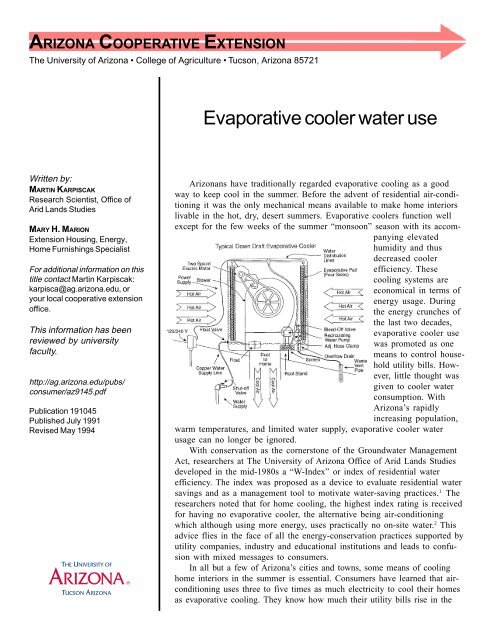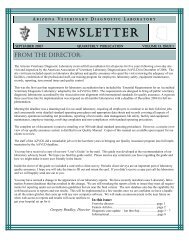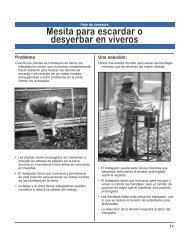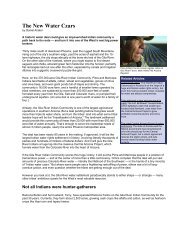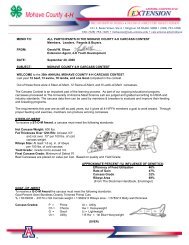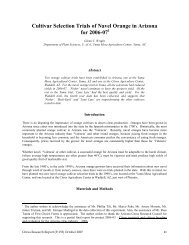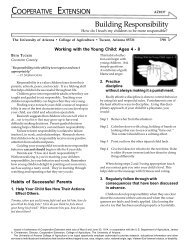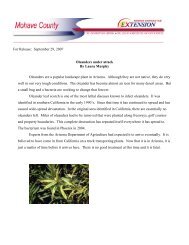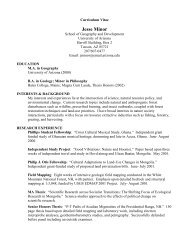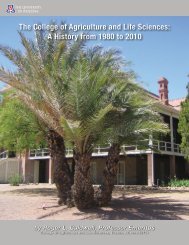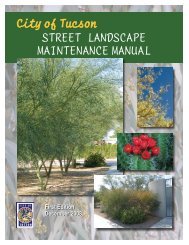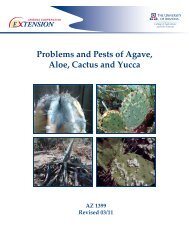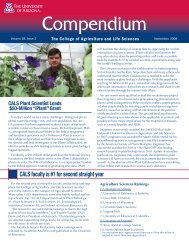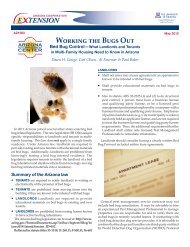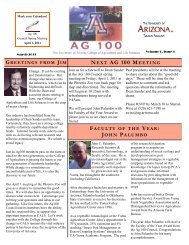Evaporative cooler water use - University of Arizona
Evaporative cooler water use - University of Arizona
Evaporative cooler water use - University of Arizona
Create successful ePaper yourself
Turn your PDF publications into a flip-book with our unique Google optimized e-Paper software.
ARIZONA COOPERATIVE EXTENSION<br />
The <strong>University</strong> <strong>of</strong> <strong>Arizona</strong> • College <strong>of</strong> Agriculture • Tucson, <strong>Arizona</strong> 85721<br />
Written by:<br />
MARTIN KARPISCAK<br />
Research Scientist, Office <strong>of</strong><br />
Arid Lands Studies<br />
MARY H. MARION<br />
Extension Housing, Energy,<br />
Home Furnishings Specialist<br />
For additional information on this<br />
title contact Martin Karpiscak:<br />
karpisca@ag.arizona.edu, or<br />
your local cooperative extension<br />
<strong>of</strong>fice.<br />
This information has been<br />
reviewed by university<br />
faculty.<br />
http://ag.arizona.edu/pubs/<br />
consumer/az9145.pdf<br />
Publication 191045<br />
Published July 1991<br />
Revised May 1994<br />
<strong>Evaporative</strong> <strong>cooler</strong> <strong>water</strong> <strong>use</strong><br />
<strong>Arizona</strong>ns have traditionally regarded evaporative cooling as a good<br />
way to keep cool in the summer. Before the advent <strong>of</strong> residential air-conditioning<br />
it was the only mechanical means available to make home interiors<br />
livable in the hot, dry, desert summers. <strong>Evaporative</strong> <strong>cooler</strong>s function well<br />
except for the few weeks <strong>of</strong> the summer “monsoon” season with its accompanying<br />
elevated<br />
humidity and thus<br />
decreased <strong>cooler</strong><br />
efficiency. These<br />
cooling systems are<br />
economical in terms <strong>of</strong><br />
energy usage. During<br />
the energy crunches <strong>of</strong><br />
the last two decades,<br />
evaporative <strong>cooler</strong> <strong>use</strong><br />
was promoted as one<br />
means to control ho<strong>use</strong>hold<br />
utility bills. However,<br />
little thought was<br />
given to <strong>cooler</strong> <strong>water</strong><br />
consumption. With<br />
<strong>Arizona</strong>’s rapidly<br />
increasing population,<br />
warm temperatures, and limited <strong>water</strong> supply, evaporative <strong>cooler</strong> <strong>water</strong><br />
usage can no longer be ignored.<br />
With conservation as the cornerstone <strong>of</strong> the Ground<strong>water</strong> Management<br />
Act, researchers at The <strong>University</strong> <strong>of</strong> <strong>Arizona</strong> Office <strong>of</strong> Arid Lands Studies<br />
developed in the mid-1980s a “W-Index” or index <strong>of</strong> residential <strong>water</strong><br />
efficiency. The index was proposed as a device to evaluate residential <strong>water</strong><br />
savings and as a management tool to motivate <strong>water</strong>-saving practices. 1 The<br />
researchers noted that for home cooling, the highest index rating is received<br />
for having no evaporative <strong>cooler</strong>, the alternative being air-conditioning<br />
which although using more energy, <strong>use</strong>s practically no on-site <strong>water</strong>. 2 This<br />
advice flies in the face <strong>of</strong> all the energy-conservation practices supported by<br />
utility companies, industry and educational institutions and leads to confusion<br />
with mixed messages to consumers.<br />
In all but a few <strong>of</strong> <strong>Arizona</strong>’s cities and towns, some means <strong>of</strong> cooling<br />
home interiors in the summer is essential. Consumers have learned that airconditioning<br />
<strong>use</strong>s three to five times as much electricity to cool their homes<br />
as evaporative cooling. They know how much their utility bills rise in the
summer months. Some have added evaporative cooling<br />
for <strong>use</strong> during the hot, dry summer months and switch<br />
to air conditioning during the “monsoon” season.<br />
Others have changed over completely to evaporative<br />
cooling, reducing their cooling utility bills. Yet<br />
evaporative cooling consumes significant amounts <strong>of</strong><br />
<strong>water</strong>, and <strong>water</strong> is a precious and increasingly costly<br />
commodity in <strong>Arizona</strong>.<br />
How much <strong>water</strong> does an evaporative <strong>cooler</strong> <strong>use</strong>?<br />
Data for evaporative <strong>cooler</strong> <strong>water</strong> <strong>use</strong> are scarce since<br />
little research on this topic has been undertaken, and<br />
many factors, from ho<strong>use</strong>hold composition to location<br />
<strong>of</strong> the <strong>cooler</strong>, influence <strong>cooler</strong> <strong>water</strong> <strong>use</strong>. In Cool<br />
Ho<strong>use</strong>s For Desert Suburbs, Jeffrey Cook, a Phoenix<br />
architect, estimates that a 4500 CFM (cubic foot per<br />
minute) <strong>cooler</strong>, under certain weather conditions, <strong>use</strong>s<br />
200 gallons <strong>of</strong> <strong>water</strong> per day. 3<br />
On the other hand, in a television interview in<br />
Tucson in September 1990, a Tucson Water Company<br />
employee stated that an evaporative <strong>cooler</strong><br />
adequafindte to cool a 1,500 square foot home <strong>use</strong>s<br />
approximately four gallons <strong>of</strong> <strong>water</strong> per hour or 96<br />
gallons per day, an estimate 50 percent lower than<br />
Cook’s. Further, the <strong>Arizona</strong> Department <strong>of</strong> Water<br />
Resources estimates that a typical Tucson ho<strong>use</strong>hold<br />
<strong>cooler</strong> <strong>use</strong>s a year-round average <strong>of</strong> 16 gallons per<br />
day. 4 These projections <strong>of</strong> <strong>water</strong> <strong>use</strong> convert to annual<br />
<strong>water</strong> costs in Tucson ranging from about $16 to $97<br />
for a 26-week cooling season.<br />
Recently, a research study was initiated by the<br />
Office <strong>of</strong> Arid Lands Studies at the <strong>University</strong> <strong>of</strong><br />
<strong>Arizona</strong> and the Water Services Department at The City<br />
<strong>of</strong> Phoenix with funding from the <strong>Arizona</strong> Department<br />
<strong>of</strong> Water Resources. This study monitored evaporative<br />
<strong>cooler</strong>s at 46 homes in Phoenix. The preliminary data<br />
from this study indicates that <strong>water</strong> usage <strong>of</strong> an evaporative<br />
<strong>cooler</strong> in Phoenix was about 7.6 gallons for each<br />
hour that the <strong>cooler</strong> was operated (4.4 gallons per hour<br />
for systems without bleed-<strong>of</strong>f and 10.4 gallons per hour<br />
for systems with bleed-<strong>of</strong>f). 5<br />
The following questions and answers are designed<br />
to improve consumer awareness, thus helping preserve<br />
our precious natural resources.<br />
Questions and answers on evaporative <strong>cooler</strong>s<br />
1. What are the major parts <strong>of</strong> an evaporative<br />
<strong>cooler</strong>?<br />
The typical evaporative <strong>cooler</strong> consists <strong>of</strong> eight<br />
major parts: housing (metal or fiberglass), a blower,<br />
recirculating <strong>water</strong> pump, <strong>water</strong> reservoir, float valve,<br />
pads, <strong>water</strong> distribution lines, and electric motor.<br />
2. How does an evaporative <strong>cooler</strong> work?<br />
The cooling process works on the principle <strong>of</strong><br />
evaporation <strong>of</strong> moisture. The fan <strong>of</strong> the <strong>cooler</strong> draws<br />
outside air through pads soaked with <strong>water</strong>. The evaporation<br />
<strong>of</strong> the <strong>water</strong> lowers the temperature <strong>of</strong> the air<br />
passing through the wet pads <strong>of</strong> the <strong>cooler</strong>. This cooled<br />
air is blown through an opening into the building.<br />
The movement <strong>of</strong> the cooled air is directed by the<br />
homeowner by means <strong>of</strong> ducts to appropriate areas<br />
around the home and exhausted from partially opened<br />
windows, doors or ceiling ducts.<br />
3. What are the ways to <strong>use</strong> evaporative <strong>cooler</strong>s?<br />
There are three ways to <strong>use</strong> evaporative cooling:<br />
(1) as the sole cooling system, (2) as a second alternative<br />
cooling system to refrigeration (air conditioning,<br />
heat pump), and (3) as a “dual” or “combined” system<br />
with a refrigeration system.<br />
One advantage to having both systems is that you<br />
get the best <strong>of</strong> two worlds - evaporative cooling during<br />
the dry months in spring and fall, and refrigeration in<br />
the hot summer months when the temperature and<br />
humidity are higher.<br />
Despite the convenience <strong>of</strong> the combined system,<br />
there are drawbacks. For example, considerable air<br />
movement is required for comfort with evaporative<br />
cooling. Refrigeration ducts are <strong>of</strong>ten too small for this<br />
Aspenwood fiber pad<br />
Paper cellulose pad<br />
<strong>Arizona</strong> Cooperative Extension • 2
and result in insufficient air flow and more noise. Also<br />
from the utility standpoint, the <strong>use</strong> <strong>of</strong> both systems<br />
results in an enhancement <strong>of</strong> the peaking problem for<br />
both <strong>water</strong> and power suppliers and, therefore, contribute<br />
to the need for additional capacity <strong>of</strong> these systems<br />
which are poorly utilized in <strong>of</strong>f-peak demand periods.<br />
For systems using shared ductwork, dampers must<br />
be installed to separate the two units. Without dampers,<br />
refrigerated air will escape to the outside through the<br />
evaporative <strong>cooler</strong> and, conversely, moist air from the<br />
evaporative <strong>cooler</strong> will enter and corrode the refrigeration<br />
unit. Many systems have dampers that are automatic.<br />
They should be checked annually for correct<br />
operation.<br />
Care must be <strong>use</strong>d when operating the evaporative<br />
<strong>cooler</strong> and refrigeration unit alternately. The refrigeration<br />
system will work much harder than normal since it<br />
has to remove the moisture brought into the ho<strong>use</strong> by<br />
the evaporative <strong>cooler</strong>. Moisture from the <strong>cooler</strong> will<br />
condense on the refrigeratant coil and increase electrical<br />
costs appreciably; therefore, one should not directly<br />
precool air to be refrigerated. 6<br />
4. Where are <strong>cooler</strong>s typically placed on a building?<br />
<strong>Evaporative</strong> <strong>cooler</strong>s can be classified according to<br />
the position <strong>of</strong> the <strong>cooler</strong> in relation to the building.<br />
Generally, there are three types: (a) down-draft (ro<strong>of</strong><br />
mounted), (b) side-draft (typically eave or window<br />
mounted), and (c) up-draft (ground mounted).<br />
Ro<strong>of</strong> mounted, down-draft <strong>cooler</strong>s (a) are sometimes<br />
preferred since they can usually be more readily<br />
connected to duct systems and are out <strong>of</strong> the way on<br />
the ro<strong>of</strong>. However, eave mounted (b) or ground<br />
mounted (c) units can be more easily and safely serviced<br />
since the person doing the maintenance does not<br />
have to <strong>use</strong> a ladder to inspect or repair the system.<br />
5. Are there any <strong>cooler</strong>s on the market that <strong>use</strong> less<br />
<strong>water</strong> than others?<br />
The <strong>use</strong> <strong>of</strong> <strong>water</strong> by <strong>cooler</strong>s is generally dependent<br />
on their size, air movement and relative humidity <strong>of</strong> the<br />
air. Therefore, all things being equal, a 4500 CFM<br />
<strong>cooler</strong> <strong>use</strong>s less <strong>water</strong> than a 6000 CFM <strong>cooler</strong>. Research<br />
is showing that some units appear to more<br />
efficiently evaporate <strong>water</strong> and, thus, produce more<br />
cooling per unit <strong>of</strong> <strong>water</strong> <strong>use</strong>. 7<br />
6. I need a new <strong>cooler</strong>, but I don’t know what size to<br />
buy.<br />
A simple formula can help you decide. First, you’ll<br />
need to determine your home’s cubic footage. Multiply<br />
the square footage (length by width) <strong>of</strong> the floor area<br />
by the ceiling height and divide by two. For example, a<br />
1600 square foot home multiplied by a ceiling height<br />
<strong>of</strong> eight feet is 12,800 cubic feet, divided by two is<br />
6400. An evaporative <strong>cooler</strong> with a CFM number<br />
closest to 6400 should be adequate for your home.<br />
CFM are usually clearly marked on the front <strong>of</strong> the<br />
<strong>cooler</strong>. Consult with your <strong>cooler</strong> supplier about <strong>cooler</strong><br />
size. Too large or too small <strong>cooler</strong>s are wasteful <strong>of</strong> both<br />
<strong>water</strong> and energy and will not provide the comfort or<br />
efficient <strong>use</strong> <strong>of</strong> resources you are seeking for your<br />
home.<br />
7. Should I buy a <strong>cooler</strong> with a two-speed motor?<br />
The advantage <strong>of</strong> a two-speed system is that low<br />
speed can be <strong>use</strong>d at night when exterior temperatures<br />
drop or on days when temperatures are not excessive.<br />
Low speed could also be <strong>use</strong>d during the day when<br />
family members are working. When family members<br />
return home, high speed would quickly lower the<br />
temperature. Coolers usually run more quietly at low<br />
speed and provide about 66 percent <strong>of</strong> the airflow <strong>of</strong><br />
<strong>Arizona</strong> Cooperative Extension • 3
high speed. They also <strong>use</strong> about 30 percent <strong>of</strong> the<br />
energy needed to run the <strong>cooler</strong> at high speed, thus<br />
reducing operating costs. Many individuals believe it is<br />
more economical overall to leave the <strong>cooler</strong>s <strong>of</strong>f when<br />
the building is not occupied.<br />
8. Do <strong>cooler</strong>s <strong>use</strong> less <strong>water</strong> when operating at low<br />
speed?<br />
The amount <strong>of</strong> cooling generated by an evaporative<br />
<strong>cooler</strong> is a function <strong>of</strong> the amount <strong>of</strong> evaporation that<br />
occurs in the unit. Increased dry air movement over the<br />
wet <strong>cooler</strong> pads will increase the amount <strong>of</strong> evaporation<br />
and produce more cool air. At the same time,<br />
decreased air movement will decrease the amount <strong>of</strong><br />
<strong>water</strong> <strong>use</strong>d for cooling, while the bleed-<strong>of</strong>f rate will<br />
remain the same.<br />
9. How <strong>of</strong>ten should maintenance be performed on<br />
an evaporative <strong>cooler</strong>?<br />
A <strong>cooler</strong> should be inspected monthly and serviced<br />
as needed during operation. The owner’s manual<br />
should be read to determine if more frequent servicing<br />
is required. Before starting any maintenance operations,<br />
read all operating and maintenance instructions<br />
and observe all cautions and warnings. During these<br />
maintenance inspections all parts should be inspected<br />
for wear or damage. Belt tension and <strong>water</strong> level in the<br />
reservoir should be checked. Since cooling efficiency<br />
is determined by how much <strong>water</strong> is evaporated, it is<br />
important to see that the pads receive a uniform wetting<br />
and be thoroughly wet at all times to provide the most<br />
cooling. Dry spots will greatly decrease cooling efficiency.<br />
The <strong>Arizona</strong> Department <strong>of</strong> Commerce Energy<br />
Office publishes a pamphlet that describes in detail<br />
<strong>cooler</strong> maintenance procedures. 8<br />
10. My neighbor’s system operates on a thermostat.<br />
Is there any advantage to that?<br />
A thermostat can be set to start the <strong>cooler</strong> when a<br />
certain temperature, for example 80 degrees, is reached<br />
in the home. When the <strong>cooler</strong> is not operating, it is<br />
using neither <strong>water</strong> nor energy. Thermostats cost from<br />
$30.00 - $45.00. Timers can also be <strong>use</strong>d to start the<br />
<strong>cooler</strong> and begin the cooling <strong>of</strong> the home prior to the<br />
arrival <strong>of</strong> the family. The <strong>use</strong> <strong>of</strong> 2 function thermostats<br />
starts the wetting <strong>of</strong> the <strong>cooler</strong> pads prior to air movement<br />
and thus prevents the blowing <strong>of</strong> dry air into the<br />
residence.<br />
11. What kind <strong>of</strong> pads should I <strong>use</strong> in my <strong>cooler</strong>?<br />
Cooler pads (sometimes called media) come in<br />
several alternatives. <strong>University</strong> <strong>of</strong> <strong>Arizona</strong> agriculture<br />
engineers have long recommended aspenwood fiber<br />
pads. They are encased in chemically treated cheesecloth<br />
to absorb more <strong>water</strong>, and they <strong>of</strong>fer the least<br />
amount <strong>of</strong> resistance to air flow through the <strong>cooler</strong>.<br />
Aspenwood pads can be <strong>use</strong>d for an entire cooling<br />
season. Although aspenwood pads are efficient in<br />
distributing cooled air, they may also produce debris in<br />
the <strong>water</strong> reservoir, increasing <strong>cooler</strong> maintenance.<br />
Some <strong>cooler</strong> manufacturers recommend a cellulose<br />
fiber media or pad for <strong>use</strong> with their equipment. The<br />
media is said to be uniform throughout, to provide<br />
consistent cooling performance and to last for several<br />
seasons. They are superior to spun aluminum and<br />
plastic pads available at hardware or do-it-yourself<br />
stores or supermarkets. These are less expensive<br />
initially than aspenwood but may need to be changed<br />
several times in one cooling season.<br />
The newer single pad <strong>cooler</strong>s require a much<br />
thicker pad. This type <strong>of</strong> pad is more expensive than<br />
the traditional aspenwood fiber pad but is designed to<br />
last for several years if the <strong>cooler</strong> is operated in compliance<br />
with the owner’s manual.<br />
12. Do the minerals in hard <strong>water</strong> affect the operation<br />
<strong>of</strong> evaporative <strong>cooler</strong>s?<br />
Mineral deposits and scale build-up ca<strong>use</strong>d by hard<br />
<strong>water</strong> can ca<strong>use</strong> rust and corrosion in metal <strong>cooler</strong>s.<br />
Some estimates are that this rust and corrosion can<br />
shorten a <strong>cooler</strong>’s life by 50 percent. Further, scale<br />
build-up on <strong>cooler</strong> pads can ca<strong>use</strong> uneven distribution<br />
<strong>of</strong> <strong>water</strong>, leading to “hot spots” on the pads and reduced<br />
cooling beca<strong>use</strong> <strong>of</strong> reduced air flow. Some<br />
manufacturers recommend installing a “bleed-<strong>of</strong>f”<br />
valve to the recirculating <strong>water</strong> line. A bleed-<strong>of</strong>f valve<br />
is installed in the recirculating line and is typically<br />
connected to a drain line or directed to irrigate turf<br />
areas or other landscaping. This results in draining part<br />
<strong>of</strong> the recirculating <strong>water</strong>, reducing buildup <strong>of</strong> hard<br />
<strong>water</strong> minerals. Bleed-<strong>of</strong>f valves are controversial<br />
beca<strong>use</strong> it is estimated that they increase <strong>cooler</strong> <strong>water</strong><br />
usage from 10 to 50 percent. Data from the Phoenix<br />
<strong>cooler</strong> study indicates that bleed-<strong>of</strong>f systems <strong>use</strong> an<br />
average <strong>of</strong> about 8,650 gallons during the cooling<br />
season. 9 Horticulture specialists discourage collecting<br />
bleed-<strong>of</strong>f <strong>water</strong> for irrigating plants. The high concentration<br />
<strong>of</strong> minerals in the <strong>water</strong> may kill or damage<br />
plants. 10 The high salt content also can result in the<br />
sealing <strong>of</strong> soils, especially soils with a high clay content,<br />
thus preventing moisture penetration. Some plant<br />
species such as Bermuda and salt grass can tolerate the<br />
high salt content <strong>water</strong>. 11<br />
<strong>Arizona</strong> Cooperative Extension • 4
Bill Witschi, the Water Systems Manager at the<br />
<strong>University</strong> <strong>of</strong> <strong>Arizona</strong>, suggests that bleed-<strong>of</strong>f should<br />
be about 1/3 makeup <strong>water</strong>. The rate could be lowered<br />
if no scale is observed forming on the <strong>cooler</strong> pads. 12<br />
13. If I decide not to install a bleed-<strong>of</strong>f valve beca<strong>use</strong><br />
it increases <strong>water</strong> usage, what can I do to prolong<br />
the life <strong>of</strong> the <strong>cooler</strong>?<br />
Thorough cleaning <strong>of</strong> the <strong>cooler</strong> is suggested to<br />
remove mineral deposits and scale build-up at least<br />
once during the cooling season. Additives to the <strong>water</strong><br />
supply also are available to help reduce scale build-up.<br />
Chemicals will not reduce scale build-up but they can<br />
increase the solubility <strong>of</strong> calcium and other minerals,<br />
thus allowing a lower bleed-<strong>of</strong>f rate, or they can<br />
combine with the calcium and produce a s<strong>of</strong>ter scale<br />
that is easier to remove. 13 Some <strong>cooler</strong> manufacturers<br />
do not recommend their <strong>use</strong> beca<strong>use</strong> they may damage<br />
the protective coating on the <strong>cooler</strong>. Caution should<br />
also be exercised about what chemicals are <strong>use</strong>d<br />
beca<strong>use</strong> these can be blown into the home during the<br />
normal operation <strong>of</strong> the <strong>cooler</strong>. 14 Ask your <strong>cooler</strong><br />
supplier. However, you may have to replace the <strong>cooler</strong><br />
sooner than you would if you <strong>use</strong>d a bleed-<strong>of</strong>f valve.<br />
14. Can <strong>cooler</strong>s be <strong>use</strong>d to circulate air only, without<br />
<strong>water</strong>?<br />
With cool air in the evening and nighttime hours,<br />
the <strong>cooler</strong> fan can be run with dry pads. This brings<br />
cool air into the home and circulates it without using<br />
<strong>water</strong>. Ceiling and/or oscillating fans <strong>use</strong>d in occupied<br />
rooms can help circulate the air for increased comfort.<br />
If <strong>cooler</strong> pads have been allowed to dry out, either<br />
through non-<strong>use</strong> or by circulating air only, it is advisable<br />
to run the pump and saturate the pads thoroughly<br />
before running the <strong>cooler</strong> fan. This ensures that <strong>cooler</strong><br />
air begins to circulate sooner and reduces the introduction<br />
<strong>of</strong> dust and pollen into the home.<br />
If you switch to air conditioning during the “monsoon”<br />
season and then switch back to the evaporative<br />
<strong>cooler</strong> as the relative humidity decreases at the end <strong>of</strong><br />
the rainy season, remember that standing <strong>water</strong> in the<br />
<strong>cooler</strong> pan is a stagnant pool. This <strong>water</strong> can become a<br />
good place for the growth <strong>of</strong> bacteria, even the bacteria<br />
that ca<strong>use</strong>s Legionnaire’s Disease. For safety it is best<br />
to drain the <strong>cooler</strong> if it will not be <strong>use</strong>d for several<br />
days. Alternatively, the <strong>water</strong> in the <strong>cooler</strong> pan can be<br />
treated with chlorine for at least 30 minutes before<br />
turning the <strong>cooler</strong> back on15 .<br />
15. How much does a new <strong>cooler</strong> cost?<br />
A new, completely installed 4500 CFM <strong>cooler</strong> costs<br />
about $700. Coolers are available for less money and<br />
for more money. This is an “average” figure.<br />
16. Should s<strong>of</strong>tened <strong>water</strong> be <strong>use</strong>d to operate an<br />
evaporative <strong>cooler</strong>?<br />
The sodium added to <strong>water</strong> by <strong>water</strong> s<strong>of</strong>tening will<br />
accumulate on the <strong>cooler</strong> pads and will become concentrated<br />
in the <strong>water</strong> reservoir. S<strong>of</strong>tened <strong>water</strong> also<br />
may increase the need for pad maintenance and the rate<br />
<strong>of</strong> rusting <strong>of</strong> metal <strong>cooler</strong> parts.<br />
17. What are ceiling vents?<br />
Ceiling vents or open windows are required to<br />
permit the exhaustion <strong>of</strong> the air blown into the home by<br />
the blower. Unlike refrigeration systems which recycle<br />
air within the home, <strong>cooler</strong>s blow large volumes <strong>of</strong><br />
cooled outside air into the living areas, and this air<br />
needs to be vented from the home.<br />
Ceiling vents make it possible to keep windows and<br />
doors closed while the <strong>cooler</strong> is running. This is helpful<br />
for security. These prefabricated exhaust ducts are<br />
installed in the ceiling in several rooms <strong>of</strong> the home.<br />
These exhaust air into the attic which must have an<br />
adequate amount <strong>of</strong> vents. UL tested ducts that automatically<br />
close in case <strong>of</strong> fire are available from <strong>cooler</strong><br />
equipment suppliers. The venting <strong>of</strong> ho<strong>use</strong> air into the<br />
attic will also reduce the air temperature in the attic and<br />
thus the amount <strong>of</strong> heat gain in the living area <strong>of</strong> the<br />
home.<br />
Homeowners could also benefit from window<br />
stops, available from most hardware stores for almost<br />
all types <strong>of</strong> windows. With stops in place, windows<br />
cannot be opened beyond a certain point chosen by the<br />
homeowner, usually 6 to 8 inches. they are easy to<br />
install, very inexpensive, and discourage entry. Plants<br />
with many spines and thorns, such as cactii and other<br />
desert species, can also be planted near windows to<br />
enhance security.<br />
18. How much does it cost to operate an evaporative<br />
<strong>cooler</strong>?<br />
Studies have indicated that the average annual<br />
cooling energy usage for a 1,600 square foot home is<br />
approximately 6,000 kilowatt hours for refrigeration<br />
and 1,500 kilowatt hours for evaporative cooling.<br />
If electricity costs were 10 cents per kilowatt hour<br />
(a sample cost), the average annual cost would be<br />
$600.00 for a refrigeration system versus $151.00 for<br />
evaporative cooling. However, the cost <strong>of</strong> <strong>water</strong> must<br />
<strong>Arizona</strong> Cooperative Extension • 5
e added to the electricity cost for evaporative cooling.<br />
Based on the cost <strong>of</strong> $2.00 for 1 Ccf (hundred cubic<br />
feet or 740 gallons), the <strong>use</strong> <strong>of</strong> about 19,000 gallons <strong>of</strong><br />
<strong>water</strong> by an evaporative <strong>cooler</strong> with a bleed-<strong>of</strong>f system<br />
the average annual cost for <strong>water</strong> would be $54.00 for<br />
an evaporative <strong>cooler</strong> compared to $0 for a refrigeration<br />
system.<br />
It should be remembered that <strong>water</strong> and energy are<br />
inseparable. It takes 0.5 gallons <strong>of</strong> <strong>water</strong> to generate 1<br />
kwh <strong>of</strong> electricity 16 and electricity is needed to treat,<br />
pump and/or transport <strong>water</strong> to your home.<br />
19. Why cover a <strong>cooler</strong> during winter?<br />
A <strong>cooler</strong> cover can provide protection for the<br />
<strong>cooler</strong> from rain, dust, and wind, and this helps to<br />
extend the life <strong>of</strong> the unit.<br />
Like any other space heating or cooling system,<br />
evaporative <strong>cooler</strong>s have advantages and disadvantages.<br />
Listed below are points consumers should weigh<br />
carefully in deciding how to cool their homes for<br />
summer comfort while trying to conserve <strong>water</strong> and<br />
energy, not only for the present but for future generations<br />
<strong>of</strong> <strong>Arizona</strong>ns.<br />
Advantages<br />
1. Coolers are economical to operate, using one-third<br />
the energy <strong>of</strong> refrigerated air-conditioning.<br />
2. Installing a new evaporative cooling system adequate<br />
for a 1,500-square-foot home costs about $700.<br />
For the same home, installing a new air-conditioning<br />
system, using existing duct work, costs about $2,500.<br />
3. Most <strong>cooler</strong> maintenance and repairs can be accomplished<br />
by the homeowner.<br />
4. Most <strong>cooler</strong> replacement parts (pads, belts, etc.) are<br />
nominal in cost when compared to air-conditioning<br />
system replacement parts.<br />
5. Coolers bring fresh, cooled, outside air into the<br />
home.<br />
6. Coolers provide a healthy environment for plants.<br />
Disadvantages<br />
1. Coolers <strong>use</strong> on-site <strong>water</strong>, a non-renewable resource<br />
in some parts <strong>of</strong> <strong>Arizona</strong>, for cooling.<br />
2. Coolers are aesthetically unattractive if not maintained<br />
and overflow <strong>of</strong> concentrated salts from the<br />
<strong>cooler</strong> can damage ro<strong>of</strong>s.<br />
3. Air velocity when operating on high speed may<br />
ca<strong>use</strong> annoying noise.<br />
4. Open windows to exhaust air may be a security<br />
hazard. This can be overcome by installing ceiling<br />
vents. Adequate attic ventilation is necessary for ceiling<br />
vents to function properly.<br />
5. Cooled air may bring dust and pollen into the home<br />
causing discomfort for allergy sufferers. Growth <strong>of</strong><br />
microorganisms such as molds on the <strong>cooler</strong> pads may<br />
ca<strong>use</strong> allergy problems in sensitive individuals.<br />
6. Coolers require regular maintenance, difficult if the<br />
<strong>cooler</strong> is ro<strong>of</strong>-mounted.<br />
Things to consider before deciding<br />
The first is cost. Get at least three estimates from<br />
reliable cooling suppliers or contractors in your community,<br />
and don’t forget to include the hidden costs,<br />
like installation, maintenance, and operational costs <strong>of</strong><br />
utilities (electricity and <strong>water</strong>).<br />
Perhaps the greatest advantage <strong>of</strong> evaporative<br />
cooling is the low cost: about one-third as much as<br />
refrigeration. The costs for operating a system will<br />
depend on the size and number <strong>of</strong> units, and how<br />
homeowners choose to run the evaporative <strong>cooler</strong> or<br />
refrigeration unit and the overall thermal properties <strong>of</strong><br />
the home (insulation, thermal mass, amount <strong>of</strong> window<br />
area, orientation <strong>of</strong> the structure).<br />
The next consideration is comfort. <strong>Evaporative</strong><br />
cooling cannot keep every home comfortable all the<br />
time. A typical desert home will not be able to achieve<br />
temperatures in what is usually considered the comfort<br />
range on days when the humidity is high. Performance<br />
can be maximized, however, if all the windows are<br />
shaded from direct sunlight, the walls are properly<br />
insulated, and protected from direct sunlight, especially<br />
on the east and west sides or passive solar concepts<br />
were <strong>use</strong>d in the construction <strong>of</strong> the home. Keep in<br />
mind that air movement, not just air temperature,<br />
contributes to comfort: 82 feels like 75 in a moderate<br />
breeze.<br />
<strong>Arizona</strong> Cooperative Extension • 6
The basic principle <strong>of</strong> evaporative cooling is simple<br />
and in the past the typical <strong>cooler</strong>s were very simple<br />
devices. More recently, however, many variations and<br />
innovative concepts are being applied to <strong>cooler</strong> design<br />
and construction to achieve cooling efficiency. Therefore,<br />
before deciding what type <strong>of</strong> cooling, air conditioner<br />
or heat pump you wish to purchase, shop by<br />
comparing their differences, comfort, capital and<br />
operating cost. For evaporative <strong>cooler</strong>s compare<br />
purchasing and operating costs, pads, construction<br />
materials (metal vs fiberglass or stainless steel).<br />
Conclusions<br />
<strong>Evaporative</strong> cooling has both advantages and<br />
disadvantages, and the choice rests with the individual<br />
homeowner. We encourage consumers to investigate all<br />
<strong>of</strong> the alternatives and make a decision based on their<br />
lifestyle and individual priorities.<br />
References<br />
1. DeCook, K. James, Kennith Foster and Martin<br />
Karpiscak, 1988. “The W-Index For Residential Water<br />
Conservation.” In Water Resources Bulletin, Vol. 24,<br />
No. 6.<br />
2. Ibid.<br />
3. Cook, Jeffrey. 1984. Cool Ho<strong>use</strong>s For Desert<br />
Suburbs. Phoenix, AZ.: <strong>Arizona</strong> Solar Energy Commission.<br />
p. 34.<br />
4. <strong>Arizona</strong> Department <strong>of</strong> Water Resources. 1991.<br />
Second Management Plan 1990-2000 Tucson Active<br />
Management Area. <strong>Arizona</strong> Department <strong>of</strong> Water<br />
Resources.<br />
5. Karpiscak, M.M., G.W. France, T.M. Babcock, and<br />
H. Johnson. 1994. <strong>Evaporative</strong> Cooler Water Use<br />
Within the City <strong>of</strong> Phoenix. Draft Final Report for 1993<br />
Cooling Season. <strong>Arizona</strong> Department <strong>of</strong> Water Resources,<br />
Phoenix Active Management Area. Prepared<br />
by the Office <strong>of</strong> Arid Lands Studies, the <strong>University</strong> <strong>of</strong><br />
<strong>Arizona</strong>, and the Water Services Department, City <strong>of</strong><br />
Phoenix.<br />
6. Witschi, Bill, <strong>University</strong> <strong>of</strong> <strong>Arizona</strong> Water Systems<br />
Manager. Written Communication. April 15, 1994.<br />
7. Karpiscak, et al. 1994.<br />
8. <strong>Arizona</strong> Department <strong>of</strong> Commerce Energy Office,<br />
n.d. Just Conserve It: Energy Conservation Notes from<br />
the <strong>Arizona</strong> Department <strong>of</strong> Commerce Energy Office,<br />
3800 North Central, Suite 1200, Phoenix, <strong>Arizona</strong><br />
85012.<br />
9. Karpiscak, et al. 1994.<br />
10. Brookbank, George. <strong>Arizona</strong> Cooperative Extension<br />
Urban Horticulturist. Telephone conversation.<br />
March 22, 1991.<br />
11. Kopec, David M., <strong>Arizona</strong> Cooperative Extension<br />
Turf and Pasture Grass Specialist. Telephone conversation.<br />
April 18, 1991.<br />
12. Witschi. 1994.<br />
13. Ibid.<br />
14. Phoenix Water Services, n.d. You Can Save Water,<br />
Money and Your Health: With an <strong>Evaporative</strong> Cooler.<br />
200 W. Washington, 8th Floor, Phoenix, <strong>Arizona</strong><br />
85003.<br />
15. Ibid.<br />
16. Settlemyre, Jay, Tucson Electric Power Company.<br />
For A Steam Generator. Telephone conversation, March<br />
14, 1994.<br />
If you have further questions, contact<br />
<strong>Arizona</strong> Energy Office<br />
3800 No. Central Ave., Suite 1200<br />
Phoenix, AZ 85012<br />
(602) 280-1402<br />
1-800-352-5499 (toll free in <strong>Arizona</strong>)<br />
Tucson Water<br />
City <strong>of</strong> Tucson<br />
P.O. Box 27210<br />
(602) 791-4331<br />
City <strong>of</strong> Phoenix<br />
Water Services Department<br />
200 W. Washington, 8th Floor<br />
Phoenix, AZ 85003<br />
(602) 256-3430<br />
Office <strong>of</strong> Arid Lands Studies<br />
845 N. Park Avenue<br />
The <strong>University</strong> <strong>of</strong> <strong>Arizona</strong><br />
Tucson, AZ 85719<br />
(602) 621-1955<br />
<strong>Arizona</strong> Cooperative Extension • 7
Any products, services, or organizations that are mentioned, shown, or indirectly implied in this publication do not imply endorsement<br />
by The <strong>University</strong> <strong>of</strong> <strong>Arizona</strong>.<br />
Issued in furtherance <strong>of</strong> Cooperative Extension work, acts <strong>of</strong> May 8 and June 30, 1914, in cooperation with the U.S.<br />
Department <strong>of</strong> Agriculture, James A. Christenson, Director, Cooperative Extension, College <strong>of</strong> Agriculture, The <strong>University</strong><br />
<strong>of</strong> <strong>Arizona</strong>.<br />
The <strong>University</strong> <strong>of</strong> <strong>Arizona</strong> College <strong>of</strong> Agriculture is an equal opportunity employer authorized to provide research, educational<br />
information and other services only to individuals and institutions that function without regard to sex, race, religion,<br />
color, national origin, age, Vietnam Era Veteran’s status, or disability.<br />
For further information on Cooperative Extension, visit http://ag.arizona.edu/extension<br />
<strong>Arizona</strong> Cooperative Extension • 8


